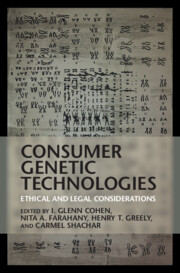Book contents
- Consumer Genetic Technologies
- Consumer Genetic Technologies
- Copyright page
- Contents
- Contributors
- Acknowledgments
- Introduction
- Part I Consumer Genetic Technologies: Rights, Liabilities, and Other Obligations
- Part II Privacy in the Age of Consumer Genetics
- Part III Tinkering with Ourselves: The Law and Ethics of DIY Genomics
- Introduction to Part III
- 10 Programming Our Genomes, Programming Ourselves
- 11 Governing Nontraditional Gene Editing
- 12 Finding a Regulatory Balance for Genetic Biohacking
- Part IV Consumer Genetics and Identity
- Part V The Impact of Genetic Information
11 - Governing Nontraditional Gene Editing
from Part III - Tinkering with Ourselves: The Law and Ethics of DIY Genomics
Published online by Cambridge University Press: 27 August 2021
- Consumer Genetic Technologies
- Consumer Genetic Technologies
- Copyright page
- Contents
- Contributors
- Acknowledgments
- Introduction
- Part I Consumer Genetic Technologies: Rights, Liabilities, and Other Obligations
- Part II Privacy in the Age of Consumer Genetics
- Part III Tinkering with Ourselves: The Law and Ethics of DIY Genomics
- Introduction to Part III
- 10 Programming Our Genomes, Programming Ourselves
- 11 Governing Nontraditional Gene Editing
- 12 Finding a Regulatory Balance for Genetic Biohacking
- Part IV Consumer Genetics and Identity
- Part V The Impact of Genetic Information
Summary
A large and highly heterogeneous group of individuals conducts genetic and genomic research outside of traditional corporate and academic settings. They can be an important source of innovation, but their activities largely take place beyond the purview of existing regulatory systems for promoting safe and ethical practices. Historically the gene-targeting technology available for non-traditional biology (NTB) experiments has been limited, and therefore they have attracted little regulatory attention. New techniques such as CRISPR-cas9, however, may create a need for alternate governance approaches. This chapter explores whether alternate governance approaches might be needed and, if so, what governance approaches would be most likely to enable non-traditional experiments to be conducted safely and ethically.
- Type
- Chapter
- Information
- Consumer Genetic TechnologiesEthical and Legal Considerations, pp. 145 - 156Publisher: Cambridge University PressPrint publication year: 2021
- 1
- Cited by



